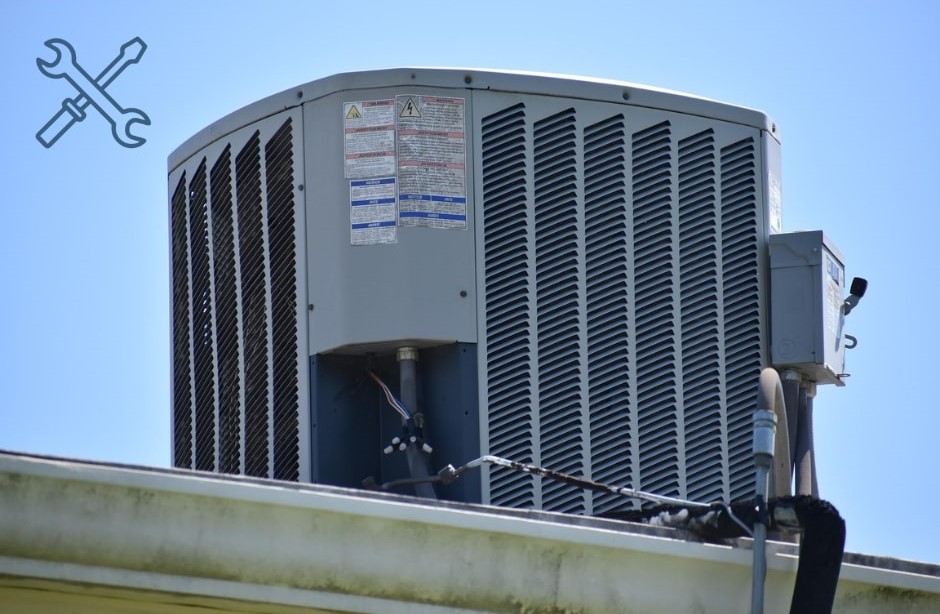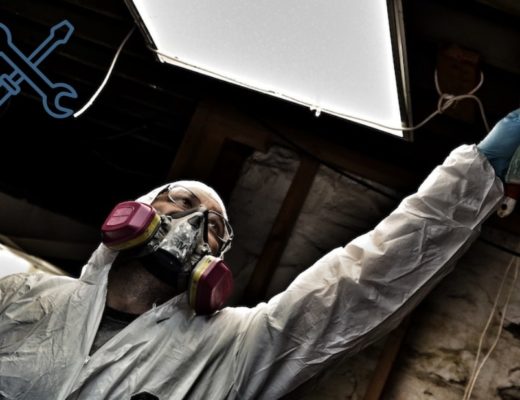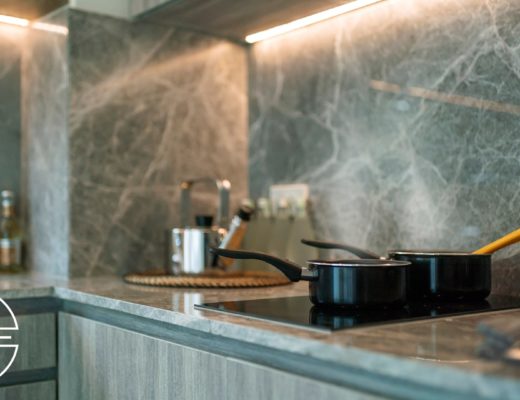Rooftop AC units are typically found in commercial properties, but they are now becoming an increasingly popular choice for cooling in residential settings.
In this article, we will discuss how they work, the factors to consider when buying one, and their installation costs. We will also go over the pros and cons of choosing this cooling solution and how to maintain it.
How It Works

Rooftop air conditioners are single units that are installed on the rooftop of a building. They are different from standard central air conditioning systems; rooftop ACs connect to your home’s ductwork, but there’s no component indoors.
Here’s how it cools your home:
- Warm air goes into the rooftop AC, passing over the evaporator coils.
- The coils use refrigerant to take the heat out of the air.
- The air gets cooler, and the refrigerant gets warmer.
- A fan blows the now cooler air through your home’s ducts.
- The warmed-up refrigerant goes to a component of the unit called the compressor, where it gets rid of the heat.
Factors to Consider Before Installing Roof AC

Before investing in a rooftop AC unit, here are some factors to consider to see if it’s the perfect fit for your home:
- Roof Condition: It’s important to evaluate the structure of your roof before installing a rooftop AC unit.
These systems are relatively heavy, and your roof needs to be strong enough to support both the weight of the unit and the installation process.
Make sure your roof is in good condition to prevent potential issues and costly repairs in the future.
- Size and Capacity: Selecting the right size and capacity for your rooftop AC unit is very important. If the unit is too small for your space, it won’t effectively cool your home.
This will lead to discomfort and higher energy bills. Conversely, an oversized unit can lead to excessive energy consumption.
To make an informed decision, it’s best to have your home professionally assessed to determine the appropriate unit size and capacity.
- Interior HVAC System Location: Air conditioners are usually placed outside the house, near the interior HVAC system.
This is done to make sure that the hoses, wires, and housing connecting these two major parts are kept in close proximity for optimal efficiency.
So, if your indoor HVAC system is in your basement or on the first floor of your house, it’s best to put the condenser unit in your yard. However, if your indoor HVAC system is up in the attic, it’s a great idea to place the unit on the roof.
What is the cost of rooftop AC unit installation?

On average, you can expect to invest anywhere from $5,500 to $11,000 when installing a rooftop AC unit.
This price can vary based on factors such as the installer’s hourly rate and the amount of time it takes to take the unit onto the roof.
This estimate only accounts for the expenses of replacing the external unit, not any additional costs related to the interior HVAC system, which could significantly increase the overall price.
It’s advisable to get in touch with a local air conditioning installer who can provide you with a detailed quote.
Pros & Cons of Installing an AC Unit on Your Roof
Pros

- Enhanced Curb Appeal: The rooftop placement of the unit keeps it out of sight in your backyard or window, which contributes to an enhanced curb appeal.
- Enhanced Ventilation: Air should flow freely in and out of the unit to function efficiently.
Ground units face more obstructions, including leaves, lawn debris, and even the house itself. Rooftop units, on the other hand, are surrounded by open space.
- Space-Saving Solution: The unit simply sits on the roof. This means you won’t have to sacrifice valuable outdoor ground space.
There’s no need to pour concrete pads, disrupt landscaping, or reduce the size of your outdoor living area.
- Less Noise: The noise generated by an outdoor air conditioner can often be heard indoors.
Although modern air conditioners are designed to be as quiet as possible, you can still hear some noise, which can be disruptive, especially when you’re trying to enjoy some outdoor relaxation.
A great benefit of rooftop air conditioner systems is their quieter operation due to the distance between the unit and you.
- Less Accidental Damage: While rooftop units may not be as shielded from the elements, they are protected against accidents caused by human error.
Their elevated position on the house shields them from mishaps like lawnmower accidents or wayward balls. Concerns about threats such as damage from pets or pests become irrelevant.
This protection contributes to the longevity of your cooling system, which is one of the most valuable advantages of rooftop air conditioning units.
- Easy Access for Routine Maintenance and Repairs: When ground-level air conditioners require repairs or maintenance, technicians need to access both indoor and outdoor equipment, which can lead to disruptions inside your home.
Rooftop air conditioners, on the other hand, are outdoors, so there’s no need for service personnel to enter your home. It’s also easier to maintain them since they are positioned at a higher level.
This means that they are less susceptible to debris accumulation that can lead to damage.
- Heightened Security: Rooftop air conditioning units are more secure compared to conventional split systems. There are individuals who may vandalize or steal air conditioners and their components.
Ground-level installations are more accessible to thieves or vandals. On the other hand, due to its elevated placement, a rooftop air conditioner is less vulnerable and any attempt to tamper with it would be very challenging.
Cons

- Higher Installation Expenses: Generally, setting up a new AC unit comes at an average cost of approximately $5,900. However, a rooftop AC unit can escalate to as much as $11,000.
- Potential Oversight: Detecting minor problems before they escalate into major concerns becomes a lot more challenging when your AC unit is placed out of sight.
- Ductwork Necessity: If there’s no existing ductwork, it can be more cost-effective to opt for a ductless heating and cooling system.
Otherwise, you might find yourself incurring additional expenses ranging from $1,000 to $2,700 or even more for duct installation.
- Potential Roof Damage: Rooftop AC units are heavy, and over time, they may create a low spot on your roof.
In such instances, rainwater can collect in this area, weakening the roof’s structure and it becomes more susceptible to leaks and damage.
- Weather-Related Challenges: While it’s not very common, rooftop AC units can be vulnerable to weather-related damage, particularly in cases involving lightning and strong winds.
Maintenance Tips

Regular maintenance is necessary to ensure your rooftop AC unit operates efficiently and has a long lifespan.
- Cleaning Coils: Over time, dirt and debris can accumulate on the coils of your rooftop AC unit. This buildup can impede the unit’s ability to efficiently transfer heat, which makes it less effective at cooling your home.
Regular cleaning of the coils is necessary to maintain the unit’s performance. This often involves removing dirt, leaves, and other obstructions from the coils to ensure optimal heat exchange.
- Checking Refrigerant Levels: Refrigerant is the special substance that your AC unit uses to cool the air. Low refrigerant levels can lead to reduced cooling efficiency and increased energy consumption.
A professional technician can check and adjust refrigerant levels to ensure that your system is operating at its best.
- Inspecting Ducts: The ductwork connected to your rooftop AC unit plays a very important role in distributing cooled air throughout your home. Damaged or leaking ducts can result in air loss and reduced efficiency.
Regular inspections can identify issues like leaks, loose connections, or other problems that could hamper the performance of your system.
- Replacing Air Filters: Air filters in your AC unit help maintain good indoor air quality and protect the system from dust and debris. Over time, these filters can become clogged, which can reduce airflow and force the unit to work harder.
Regular replacement of air filters is necessary to ensure that your system operates efficiently and that the air you breathe remains clean.




